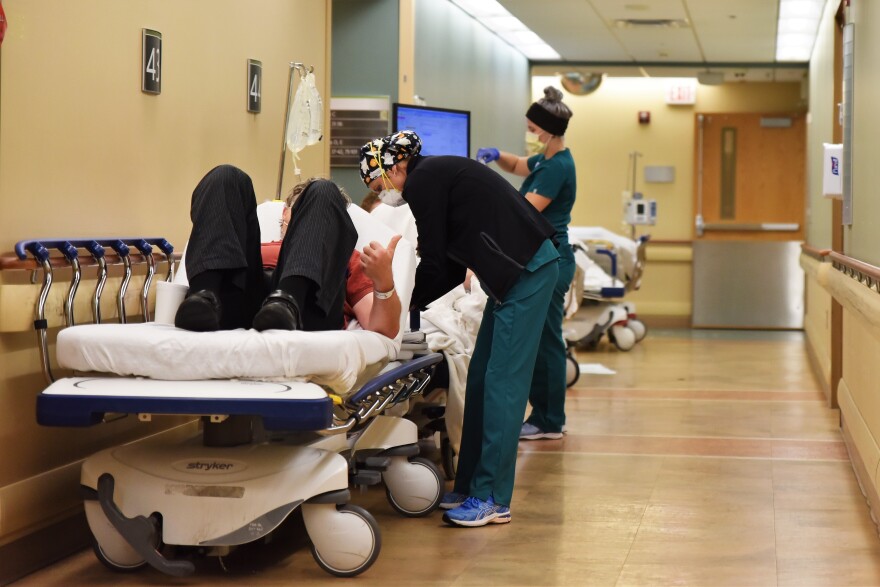More than 85% of all intensive care unit (ICU) beds and 85% of all hospital inpatient beds in Michigan are currently full, a dangerous and potentially deadly level of overcrowding as the state’s health system is strained by a fourth surge of COVID-19 cases.
At least eight hospitals are 100% full, according to the latest state data. West Michigan’s largest hospital system, Spectrum Health, has reached a system-record number of patients in both its hospitals and its ICUs. Dr. Darryl Elmouchi, Spectrum’s president, stood at his computer Friday afternoon in his Grand Rapids office, next to a row of windows looking out on a cold, gray day. Normally, they’d take up to 50 transfer patients each day from smaller hospitals or rural emergency rooms, he said. But now, they can’t.
“We’ll get phone calls saying we’re the 15th hospital they’ve called, and can we please help? And very often right now, the answer is no,” he said. “Because we have to take care of those people in front of us before we can take care of people that are coming from a distance. And that's really heartbreaking, and it’s hard.”
St. Joseph Mercy Hospital in Ann Arbor and St. Joseph Mercy Livingston Hospital are both 100% full, a spokesperson confirmed Friday.
"St. Joseph Mercy Ann Arbor and St. Joseph Mercy Livingston have been managing day-to-day ICU operations either at capacity or above standard capacity throughout much of November,” Dr. David Vandenberg, Chief Medical Officer at St. Joseph Mercy Ann Arbor and St. Joseph Mercy Livingston, said in a statement. “While patient safety remains our number one priority, the unrelenting volume of COVID-19 patients with advanced illness makes managing their care very difficult on our medical teams.”

Hospitals are also being hit by waves of non-COVID patients whose conditions have worsened after months of delayed care during the pandemic. Emergency room waits are getting longer, ambulances are overwhelmed by demand, and patients are being sent greater distances to find a hospital that can take them.
“You could be at a hospital in the U.P. and not have someone to accept you at a bigger, more capable health system right now because of this,” Elmouchi said. “...You can get in a car accident, you can have a heart attack, and you don’t get the care that you otherwise would have at the right time. Things can be delayed or changed as a result of this. Every health system, every hospital, every doctor across the state is trying to do their best for everybody. But it's hard to do that when you're stretched in capacity.”
More than 4,000 adults and 58 children are hospitalized for confirmed or suspected COVID overall. And currently, 2,651 of the state’s 3,114 ICU beds are occupied, according to the most recent state data.
Overcrowding at these levels isn’t just inconvenient. It can kill people. Once hospitals hit 75% ICU capacity, more patients die for medically-preventable reasons, according to a CDC study published last week in Morbidity and Mortality Weekly. By looking at the impacts of hospital strain between July 2020 - July 2021, researchers predicted that once the nation’s ICU beds were at 75% capacity, an estimated additional 12,000 excess deaths would occur two weeks later. “As hospitals exceed 100% ICU bed capacity, 80,000 excess deaths would be expected 2 weeks later,” the authors said.
But those are national models that are hard to drill down to a state level: neither the Michigan Department of Health and Human Services nor the Michigan Health and Hospital Association tracks deaths linked to hospital overcrowding.

“MDHHS does not have a model for excess deaths, but we work with facilities to monitor morgue capacity and have mobile resources to support additional morgue capacity if needed and requested,” spokesperson Bob Wheaton said Friday via email.
Asked if any health systems have adopted crisis standards of care (an emergency mode to help health care workers determine who gets life-saving care when resources are scarce), Wheaton said while they “aren’t aware of any facilities in full crisis standards of care...several have reported being between contingency and crisis.”
On November 9, Munson Healthcare announced it was moving to “Pandemic Level Red Status” for the first time in the organization’s history. That means it will prioritize “pandemic-related care...above all other issues,” including pausing some services and assessing “non-urgent surgeries on a case-by-case basis to shift staff and resources to where they are needed most.”
And across the state, some ER patients are being “placed in hallways or conference rooms,” while hospitals divert others away “because there is no physical room or medical staff available to accept more patients,” the Michigan Health and Hospital Association said in a letter from Chief Medical Officers across the state earlier this week.
“...Just as hospitals and the staff working inside are and have been working at capacity, our emergency medical services (EMS) are also stressed and overworked. There may be times when capacity in the system is not adequate to accommodate the usual response and speed of transport, especially for out-of-area transfers.”
The U.S. Department of Defense has agreed to a request from Governor Gretchen Whitmer’s administration for federal teams to come assist Spectrum Health in Grand Rapids and Beaumont Hospital in Dearborn.
Meanwhile, health leaders continue to plead with the public: please, get vaccinated.
“Every day folks say, ‘Well, but you know, people with vaccines can still get COVID,’” Elmouchi said. “They can. But our data, as recently as two days ago, shows that 91% of those that are hospitalized...in our 14 hospitals are here unvaccinated. And so the key to this in my mind is not, we're never going to get rid of [COVID]. But if we can minimize it and make it much less of a severe illness, we'll do better.”
It would be one thing if COVID cases and hospitalizations showed signs of leveling off, Elmouchi said. But the trend lines keep rising, with the state poised to break a record number of COVID inpatients.
“The COVID numbers day by day just keep creeping up,” he said. “And at this point, there’s not an end in sight to that.”



